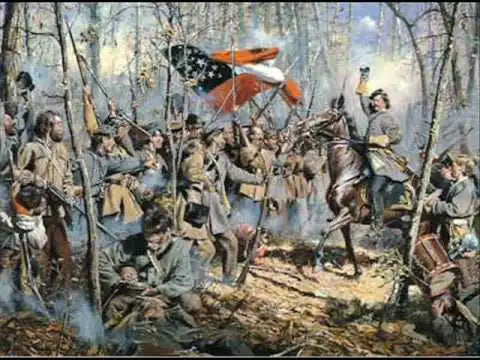
The following articles were written by a tour guide who works at the Shiloh Battlefield in Tennessee. This being the 160th anniversary of the battle (April 6-7, 1862), I thought it only appropriate to share.
SHILOH TREE LINES
I re-found this postcard among my many saved pictures. This is of course the 2nd Tennessee Monument, just South of Shiloh Church, and the Louisiana Crescent Regiment monument on the Hamburg-Purdy Road, across from the Davis Wheatfield. I do not know what year this is. I was amazed by how far back the tree lines are here.
The 2nd Tennessee monument today sits in a fairly small field. The Crescent regiment marker has a tree line to within 10 feet of it. I know the tree lines at Shiloh were kept pretty close to correct up to World War II. The war sucked all the men into the army, or into war vital jobs. I understand the Park Service was somewhat gutted until the late 1940’s, and the tree lines at Shiloh were just left to grow, during the war, and up to about 1950 or so.
These look like colorized photos. Perhaps they had slightly, or largely, different backgrounds painted in? The Tennessee monument background looks fairly correct, showing Shiloh Branch back to the left.
Starke Miller
Miller Civil War Tours

THE LAST CONFEDERATE COUNTER CHARGE AT SHILOH, AND THE UNIVERSITY of MISSISSIPPI ALUMNI WHO LED IT
This is straight out of the book, Old Guard in Gray, which is a collection of biographies of Memphis, and Shelby County, Tennessee Confederate Veterans.
Late on the afternoon of April 7, which was the second day of the battle of Shiloh, the Confederate Army had been beaten and was in retreat. The wagons with the wounded were the last to get off the field, just South of the Shiloh church, at a small creek crossing at Shiloh Branch. There was only one small bridge there, and the wagons were bunched up there, trying to get away from the pursuing Union Army.
Confederate General Cheatham, seeing this, ordered the 38th Tennessee Infantry back to the top of the hill, and into the small cemetery around Shiloh Church. Colonel Looney of the 38th told General Cheatham that they could not do much because they averaged only one round of ammunition per man. General Cheatham told Looney to Crescent buy the wagons all the time that he could. The lieutenant colonel of the 38th Tennessee was Hugh D. Greer. He was an 1856 graduate of the University of Mississippi.
Some 3 to 400 hundred brave men of the 38th Tennessee, and several other regiments, spread across the church yard and cemetery, and out into the woods, determined to hold back, at least for a while, the Union pursuit. Those men formed in line of battle in a cemetery, waiting to die there, if need be, in order to save some of their friends. They fixed bayonets and waited.
They let the Union skirmishers practically walk on top of them, until the main Union troops came into sight. Then they raised up, fired one volley, and made a bayonet charge with a Rebel yell on the Union troops! It is said they drove those blue bellies nearly a quarter of a mile back to the crossroads area. Greer’s men were then able to form up, and retreat in good order, all the Confederate wagons having successfully gotten across the bridge to safety.
Hugh D. Greer, in his telling of this charge, stated that the colonel of the regiment, Colonel Looney, sat behind the line of battle on his horse, encouraging the boys the whole time! Lieutenant Colonel Greer apparently led the charge, was wounded in the head, and captured on the field. Greer may have had some feelings about the colonel not participating in the charge.
Colonel Looney was a Shiloh Battlefield Commissioner from 1895 to his death in 1899. Greer said that as a prisoner, Union General Sherman asked him why his men had only fired one round, and then made a bayonet charge. Greer told him the truth, that most of his men only had one round. Greer said Sherman grasped his hand warmly and shook it, congratulating him on being a member of such a gallant command.
Hugh D. Greer was exchanged from the Union prison Camp in the summer of 1862. He later became the colonel of the 38th Tennessee, and he survived the war. He was run over and killed by a train, at what was
Buntyn, Tennessee in 1899. Buntyn is now part of Memphis, and is the old train station near the University of Memphis. Greer was one of the 109 University of Mississippi students and alumni who fought at Shiloh, in 20 different southern regiments. I love them all. The University has turned out some brave, fine men.

If you ever go to Shiloh with me, I will stand with you there at Shiloh Church, in the small cemetery, and I will tell you this story, and just a few others.
Starke Miller
Miller Civil War Tours
(Articles courtesy of The Southern Comfort, publication of the Private Samuel A. Hughey Camp 1452 Sons of Confederate Veterans and the President Jefferson Davis chapter of the Military Order of the Stars and Bars, volume 46, Issue #4, April 2022 ed.)

